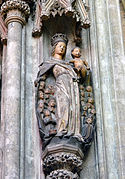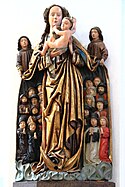Darmstadt Madonna
Holbein painted the first stage of this work for Jakob Meyer, one of his most important patrons and former mayor of Basel, before he left for England in 1526; he worked again on the painting after returning to Basel in 1528, adding details such as the headdress of Meyer's daughter, Anna, bottom right, representing her betrothal.
By the time this work was painted, the staunchly Catholic Meyer was yesterday's man in Basel, which was coming increasingly under the influence of the Reformation. Holbein was seemingly compliant with the reformers' principles, and this work represents his last orthodox Marian image. The style is a mixture of the realism of early Netherlandish and German painting and, in the treatment of the boys and of the madonna and child, an Italian idealisation. The piece also functions as an epitaph in the Northern tradition. It takes the form of a Madonna of Mercy, a Schutzmantelmadonna, who covers Meyer with a mantle of protection and stands within a scalloped niche. Scholars are divided on whether the boys on the left represent real family members or idealised figures; but it is believed that the three figures on the right are Meyer's first wife, Magdalena Baer (died 1511); second wife, Dorothea Kannengiesser; and daughter Anna. In the view of art historian Jochen Sander (Müller, p. 341): "By combining the most diverse pictorial formulas, and by connecting lifelike portraits with idealised holy figures, in its stupendous handling of the surface and its masterly colourism, this painting belongs among the undisputed masterworks of sixteenth-century European painting".
References
- Oskar Bätschmann & Pascal Griener, Hans Holbein, London: Reaktion Books, 1997, ISBN 1861890400, p. 145.
- Stephanie Buck, Hans Holbein, Cologne: Könemann, 1999, ISBN 3829025831, pp. 76–82.
- Christian Müller; Stephan Kemperdick; Maryan Ainsworth; et al, Hans Holbein the Younger: The Basel Years, 1515–1532, Munich: Prestel, 2006, ISBN 9783791335803, pp. 338–41.
- Derek Wilson, Hans Holbein: Portrait of an Unknown Man, London: Pimlico, Revised Edition, 2006, ISBN 9781844139187, pp. 160–61.
Relevantní obrázky
Relevantní články
Madona Ochranitelka z Kostelce nad OhříMadona Ochranitelka z Kostelce nad Ohří je v českém středověkém sochařství vzácně dochovaným příkladem tohoto ikonografického typu na našem území. Je vystavena ve stálé expozici středověkého umění Národní galerie v Praze. .. pokračovat ve čtení








